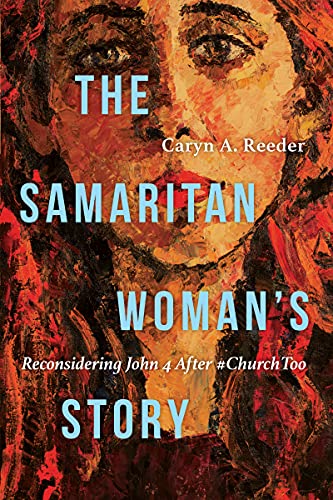
First of all this is a scholarly work. It’s well cited and researched and very in depth. This is the kind of book that will make you want to fact check things and conveniently the sources to fact check are cited right there on the page.
Second of all the main point of this book is to challenge our view that the Samaritan woman is a sexual sinner. It is often preached that the reason the Samaritan woman had so many husbands is that she was sexually promiscuous, but this story isn’t backed by Scripture. Jesus had no problem calling people sinners, but in this passage, not once does he do so. While he does point out that she’s been married multiple times, there’s no hint of calling her out because of it. It’s more stated as a fact.
Additionally, if she was the outcast we’ve been led to believe she is, why did the town so quickly listen to her and come to hear more from Jesus? Why don’t we hear them murmuring about how Jesus would come to a promiscuous women before he came to them?
Once you remove her supposed sexual sin from the narrative, the meaning and power of the story changes drastically. Instead of an incompetent woman prone to sexual promiscuity, we find an intelligent debater who talks to Jesus about serious matters of faith. It is this line of thinking that Dr. Reeder draws out in her book. And her thoughts in this matter are deep, profound, and worthy of consideration. Anyone preaching or teaching on this passage would do well to read through this book and consider the implications.
There is no way to read the facts Dr. Reeder sets out, the context of the story, and the details within it and continue to tell the story the same way we’ve always heard it. The Samaritan woman was no prostitute or sexual sinner. She lived in a time where women were greatly devalued and marriage was a thing arranged by families to gain political and financial capital.
Dr. Reeder draws out many historical interpretations of this passage and shows us that from the very earliest days of the church there were church fathers who did not believe she was an adulterer and that God cares for the lowly and protects the weak, just like this woman.
There are some things in the book that I don’t believe she developed well enough. Perhaps if I spent more time looking at her citations, I would be more moved by the argument, but as it stands there are times she points to the historical records and says “this was a common thing back then and accepted in society.” I have no doubt that those statements are true, but being accepted in society doesn’t mean they’re accepted within the religious community. You can be a Jew by lineage and not a Jew by faith. For example, just because it was acceptable for Jews to have sex once engaged (but not married to) their spouse, does not mean that religious Jews would feel the same way.
But whatever complaints I might have about the book are overshadowed by the overwhelming facts and research that went into shattering the perspective we’ve been taught that this woman was a sexual sinner and not the intelligent and spiritually curious woman the story projects.
Top Quotes
Take, for instance, biblical representations of God. Many metaphors come from nature (God is a rock or a fire). Others reflect masculine images like fathers, kings, or shepherds. But the Bible also portrays God as a woman giving birth, a mother avenging her cubs, and a woman cleaning her whole house to find a lost coin (Is 42:14, Hos 13:8, Lk 15:8-10). If we ignore these representations of God, we stunt our own knowledge of God. In the process, we make it more difficult to recognize the image of God in women.
Page 8
I have repeatedly heard that God never refers to himself with feminine descriptions and thus we should never do that too. Seeing this brief list shows that the premise of that argument is false. While we can all agree that God is neither male nor female, we can also rest assured that metaphors used to describe God take both genders and the forms of inanimate objects. We should not let gender get in the way of our describing God as accurately as possible in the metaphors we use.
We can see God describe himself as a nurturing mother raising children (Hosea 11:3-4), an eagle watching over her eggs (Deuteronomy 32:11-12), the God who gives birth to you (Deuteronomy 32:18), the mother who comforts her children (Isaiah 66:13), a mother hen (Matthew 23:37 and Luke 13:34), and so many more. God had no gender and is not offended to be described as having one or the other. He himself describes his compassion and care as feminine love and his hatred as a man going to war.
This concept is super important for women. In the biblical counseling movement we’ve seen many women struggle to relate to God because they’ve been taught that God identifies solely as male. Showing them that God does relate to women and they have things in common with him allows them an easier time trusting and loving God.
Early purity movements centered on changing men’s behavior to protect women. Today though, from adolescence onwards men hear that they are driven by physical desire and pleasure. The minimal expectation for their self-control is out weighed by the sexual objectification of women, who are simultaneously identified as inferior, weaker, and subordinate. As such, women are not taught how to say no. Instead of protecting women, purity movements endanger women.
Page 90
This has been something I’ve been grappling with for a few years. My own sexual desire consumed me for a long time, and only several years into my marriage did I begin to realize that it was largely steeped in a miseducation from purity culture.
The goal of purity culture started out as all things do, with good intentions. It aimed to curb the mistreatment of women by teaching men discipline and self-control. But over time it was corrupted and taught men that women, especially wives, can’t say no to their sexual advances. They’ve neglected to teach men to use self control, discipline, and biblical meditation to master their sexual desires. That teaching has been replaced with the lie that men can’t control their eyes and impulses and women need to wear the right clothes, talk the right way, and behave right in order for their lustful desires to be kept in check. Both genders have been greatly been harmed by this deceit.
DeMuth’s fictional retelling of the story provides the Samaritan woman with a life history of abuse, divorce, and sexual slavery. While poverty led to the woman’s immoral life, DeMuth also suggests that past abuse may have affected her ability to connect emotionally with her husbands. As is the case for many survivors, DeMuth’s Samaritan woman internalized the abuse in a deep sense of shame.
Page 94
One of the more modern perspectives taken on the Samaritan woman’s story is that far from being a sexual sinner herself, she was the victim of severe sexual abuse. This perspective turns the narrative on its head.
The church at large has only recently begun to understand how deeply damaging abuse is and to a further extent how emotionally damaging that is to the victim. If it’s true that the Samaritan woman was a sex slave, her ability to respond well to her husbands would be greatly impeded, and an ignorant or obstinate man would only make it worse. I’ve seen men who don’t understand and don’t try to understand the pain their wife has gone through in being raped result in them trying to force their wife to repeat the same sexual acts that were forced upon her in that dark hour. That kind of sinful obliviousness further destroys the victim. She was already brought low through the abuse done to her, but the person she’s supposed to trust most in the world repeating those acts upon her violates all remaining trust she has and alienates her from him.
There’s no good way to wrap up this review after such a heartrending and evil thought. My best attempt is to say that we must be careful when reading these stories in Scripture. There is culture, context, and harsh realities that are easy for us to sugar coat and turn into picturesque fantasies. But the truth is the Bible is a history book full of evils and goods and we must carefully dissect not only what our translations read, but also the surrounding facts and what God wants us to learn from it.
There are no easy answers, just a lifetime of seeking God.
Overall I give this book 4 stars.
Up Next: Biblical Words and Their Meaning: An Introduction to Lexical Semantics by Moisés Silva
